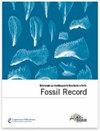中国漳浦中新世琥珀中首次发现隐花植物(月桂科)的花朵和化石证据
IF 2.1
4区 地球科学
Q3 Earth and Planetary Sciences
引用次数: 0
摘要
月桂科是被子植物化石记录最古老的科之一,已知最早的证据来自白垩纪中期。不过,这些记录大多基于叶片,尤其是来自亚洲新生代的叶片,要将其归入已灭绝或现存的属或种往往具有挑战性。相比之下,生殖器官化石的信息量更大,但仍然很少。我们在本文中描述了亚洲第一朵新生代月桂科花卉,并根据琥珀包涵物证实中新世漳浦植物区系(中国东南部福建省)中存在隐花植物。我们利用同步辐射微计算机断层扫描(SRμCT)技术对标本进行了扫描,然后将化石与现存的该属花卉进行了比较。目前的化石花朵较小,两性,多对称,花被和雄蕊为轮生和三出,雌蕊群周围有托杯。花被由六个未分化的花被片组成,雄蕊群由九个雄蕊和三个最内侧的退化雄蕊组成,雌蕊群由一个心皮和一个上位的单室(单胚珠)子房组成。我们的研究还表明,该化石与至少一个现存的澳大利亚隐花植物物种一样,在托杯边缘上有一个不寻常的典型雄蕊腺体和一个短的雄蕊管,这在以前从未有过报道。如今,月桂科植物仍然分布在热带到亚热带地区,主要是美洲和亚洲的热带雨林。在漳浦发现的许多月桂科植物叶化石以及本次研究的琥珀花,与目前重建的琥珀来源环境--中新世中期的大热季雨林--是一致的。本文章由计算机程序翻译,如有差异,请以英文原文为准。
First flower inclusion and fossil evidence of Cryptocarya (Laurales, Lauraceae) from Miocene amber of Zhangpu (China)
Lauraceae have one of the oldest fossil records of angiosperms with the earliest known evidence from the mid-Cretaceous. However, most of these records are based on leaves, especially from the Cenozoic of Asia, which are often challenging to assign to extinct or extant genera or species. In contrast, fossils of reproductive organs are more informative, but remain scarce. We here described the first Cenozoic Lauraceae flower of Asia and confirmed the presence of Cryptocarya in the Miocene Zhangpu flora (Fujian Province, south-eastern China) based on an amber inclusion. We scanned the specimen using synchrotron radiation-based micro-computed tomography (SRμCT) and then compared the fossil with extant flowers of the genus. The present fossil flower is small, bisexual, and polysymmetric, with a whorled and trimerous perianth and androecium along with a hypanthium around the gynoecium. The perianth comprises six undifferentiated tepals, the androecium consists of nine stamens and three innermost staminodes, and the gynoecium of a single carpel with a superior, unilocular (and uniovulate) ovary. Our study also shows that the fossil shares an unusual position of the typical staminal glands and a short androecial tube on the rim of the hypanthium with at least one extant Australian species of Cryptocarya, which have not been reported before. Nowadays, Lauraceae are still present in tropical to subtropical regions, mostly in American and Asian rainforests. The discovery of many Lauraceae leaf fossils in Zhangpu, as well as the amber flower of this study, is consistent with the current reconstruction of the amber source environment as a megathermal seasonal rainforest during the Mid-Miocene.
求助全文
通过发布文献求助,成功后即可免费获取论文全文。
去求助
来源期刊

Fossil Record
PALEONTOLOGY-
CiteScore
2.50
自引率
7.10%
发文量
18
审稿时长
>12 weeks
期刊介绍:
Fossil Record (FR) is the palaeontological journal of the Museum für Naturkunde Berlin. This journal was founded in 1998 under the name Mitteilungen aus dem Museum für Naturkunde Berlin, Geowissenschaftliche Reihe and appears with two issues each year. Fossil Record publishes original papers in all areas of palaeontology including the taxonomy and systematics of fossil organisms, biostratigraphy, palaeoecology, and evolution. All taxonomic groups are treated, including invertebrates, microfossils, plants, and vertebrates.
 求助内容:
求助内容: 应助结果提醒方式:
应助结果提醒方式:


